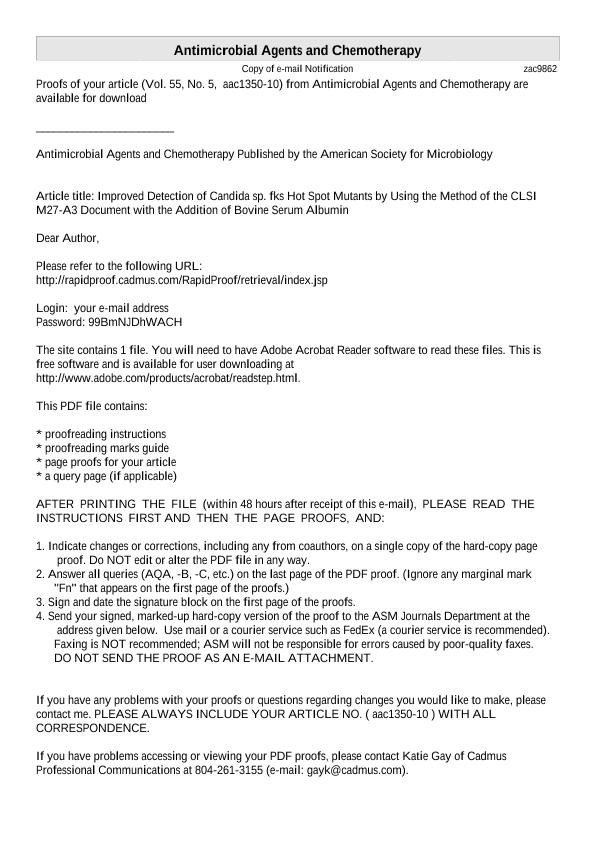Mostrar el registro sencillo del ítem
dc.contributor.author
Garcia, Guillermo Manuel

dc.contributor.author
Park, Steven
dc.contributor.author
Perlin, David S.
dc.date.available
2017-03-23T21:01:22Z
dc.date.issued
2011-03
dc.identifier.citation
Garcia, Guillermo Manuel; Park, Steven; Perlin, David S.; Improved Detection of Candida spp. fks Hot Spot Mutants by Using the Method of the CLSI M27-A3 Document with the Addition of Bovine Serum Albumin; American Society For Microbiology; Antimicrobial Agents And Chemotherapy; 55; 5; 3-2011; 2245-2255
dc.identifier.issn
0066-4804
dc.identifier.uri
http://hdl.handle.net/11336/14242
dc.description.abstract
Echinocandins are highly bound to serum proteins, altering their antifungal properties. The addition of 50% human serum to the MIC assay improves the identification of echinocandin-resistant Candida spp. harboring fks hot spot mutations. However, this modification cannot readily be applied to the method of the CLSI M27-A3 document due to safety and standardization difficulties. The aim of this study was to evaluate commercial bovine serum albumin (BSA) as a safe and standardized alternative to human serum. A collection of 28 echinocandin-susceptible strains, 10 Candida parapsilosis sensu lato strains (with naturally reduced echinocandin susceptibility), and 40 FKS hot spot mutants was used in this work. When RPMI 1640 was used for susceptibility testing, wild-type strains and
fks mutants showed MIC range overlaps ( 2, 1, and 3 2-fold-dilution steps separated these populations for anidulafungin, caspofungin, and micafungin, respectively). On the other hand, the addition of BSA to RPMI 1640
differentially increased echinocandin MIC values for these groups of strains, allowing better separation between populations, with no MIC range overlaps for any of the echinocandin drugs tested. Moreover, the use of RPMI-BSA
reduced the number of fks hot spot mutant isolates for which MIC values were less than or equal to the upper limit for the wild type (very major errors) from 9, 2, and 7 with RPMI alone to 3, 0, and 3 for anidulafungin, caspofungin, and micafungin, respectively. When RPMI-BSA was used to study the susceptibility of C. parapsilosis sensu lato species to echinocandins, the strains behaved as anidulafungin- and micafungin-resistant isolates (MIC, >8 g/ml). These data support the need for a revision of the CLSI protocol for in vitro testing of echinocandin susceptibility in order to identify all or most of the fks hot spot mutants. Also, caspofungin could be used as a surrogate marker of
reduced susceptibility to echinocandins.
dc.format
application/pdf
dc.language.iso
eng
dc.publisher
American Society For Microbiology

dc.rights
info:eu-repo/semantics/openAccess
dc.rights.uri
https://creativecommons.org/licenses/by-nc-sa/2.5/ar/
dc.subject
Echinocandins
dc.subject
Candida
dc.subject
Fks Mutants
dc.subject
Resistance
dc.subject.classification
Enfermedades Infecciosas

dc.subject.classification
Ciencias de la Salud

dc.subject.classification
CIENCIAS MÉDICAS Y DE LA SALUD

dc.title
Improved Detection of Candida spp. fks Hot Spot Mutants by Using the Method of the CLSI M27-A3 Document with the Addition of Bovine Serum Albumin
dc.type
info:eu-repo/semantics/article
dc.type
info:ar-repo/semantics/artículo
dc.type
info:eu-repo/semantics/publishedVersion
dc.date.updated
2017-03-22T15:20:22Z
dc.journal.volume
55
dc.journal.number
5
dc.journal.pagination
2245-2255
dc.journal.pais
Estados Unidos

dc.journal.ciudad
Washington
dc.description.fil
Fil: Garcia, Guillermo Manuel. Public Health Research Institute; Estados Unidos. Consejo Nacional de Investigaciones Científicas y Técnicas. Centro Científico Tecnológico Santa Fe; Argentina
dc.description.fil
Fil: Park, Steven. Public Health Research Institute; Estados Unidos
dc.description.fil
Fil: Perlin, David S.. Public Health Research Institute; Estados Unidos
dc.journal.title
Antimicrobial Agents And Chemotherapy

dc.relation.alternativeid
info:eu-repo/semantics/altIdentifier/doi/http://dx.doi.org//10.1128/AAC.01350-10
dc.relation.alternativeid
info:eu-repo/semantics/altIdentifier/url/http://aac.asm.org/content/55/5/2245
Archivos asociados
